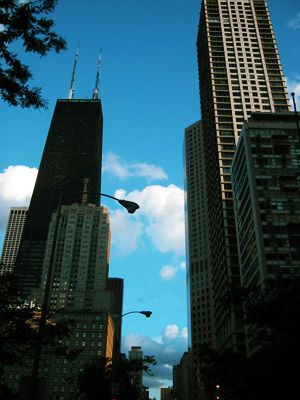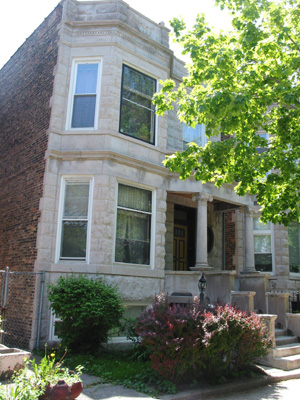Seeing Chicago from your feet is really a perspective in experiencing our city that is unforgettably intimate. Going by bicycle, car, bus or roller blade will not do it in the same way. It has to be you, your feet and the city joined in a personal dance that allows you to feel the rhythms of Chicago's neighborhoods, lakefront and exquisite signature skyline.
Using the pedestrian walkway going north from Michigan Avenue onto the beach lakefront, while walking you can turn your head toward the skyline and watch it grow larger in the distance. After 9/11 each building became personal. Each represents the best of this city in its physical beauty, its diverse population and its historical architecture. We do not own these buildings but as Chicagoans they are ours.
As your feet move through the warm soothing sand, the sunlight orchestrates a free-form ballet of glowing glass and steel. Chicago's skyline is the visible heartbeat of an exciting and proud American world-class city.
You turn your head to the right and there is blue. Blueness, blueosity, endless blue where the water meets the horizon. You climb down the levels of new fresh pavement to sit and dream. Your mind reaches out beyond what your eyes can see.

You continue your early morning walk through a Chicago neighborhood. The shops are not yet open and the frenetic pace has not yet kicked in. For this moment it is only the sound of your feet on the pavement as you deliciously browse the windows in the various buildings that house an infinite variety of merchants making their livings in this urban setting. Cuisines, nails, massages, haircuts, coffee, banks, clothing. They are all there. With "closed" signs still on their doors, some are lit within, beckoning with a promise of fulfillment to come. You stop and gaze. You feel the thriving pulse of city living. Your feet are engaged in a dance of their own as they carry you through the day's brisk yet quiet moments. You cannot get enough. You want this contemplation to last beyond the time all of this will belong to others as well.
Your steps continue down a familiar street. As you turn a corner, you find yourself standing in front of an apartment building. You look up at the top floor windows. Your husband has pointed out this location to you a million times. This is where he lived as a boy. This is where he strung tin cans to the apartment across the street where his friends who were twins lived. Young city boys talking to one another through their makeshift phone cans.
You try to imagine what it was like when your husband was a boy. You and he now live together three blocks from this childhood site. You brought him back to the city because you would live nowhere else. He has given you an inch-by-inch tour of what the city neighborhood used to be like. Before the high rises on the lakefront were built there were vacant lots where he and his friends played. He remembers open spaces and high grass. He points out the restaurants that have survived as relics.
He is especially proud of the piece of brick on his childhood apartment building where he carved his initials into fresh cement.
This visit has made you nostalgic for 4619, the address number of your old neighborhood. The next weekend you find yourself standing in front of the door of your old apartment. To knock and walk in would change the reality of the memories you cherish. So you do not knock. You are not intrusive of the past. Instead you go for a walking tour of your old Chicago neighborhood that was once a gem. Your entire extended family lived in a two-block radius.

You know where you are headed: the candy store on the corner. As you approach you are shocked to see that it is still there. It is a basement shop. You slowly walk down the steps that were so steep for you as a child and enter. The memories of the smells and images of the penny candy and toys and coloring books and rainbow colored crayons are as real as they themselves had once been.
There is a woman behind the counter. You walk closer in disbelief. It is Mrs. S. She is still there. She looks up at you and after a long pause she says your name. She remembers. Her store represents some of the best memories of your youth in this city which you love so deeply. And she remembers you.
You continue five or six more blocks and there is your elementary school, where your father had also attended as a boy. Architecturally, this is one of the old classic Chicago grammar schools. It is stately to the point of being intimidating. Or perhaps that is a perception carried over from your youth.
You enter and walk the halls where you once waited for your milk and cookies. You walk into the auditorium where you left your mother's side for the first time when the kindergarten class lined up.
The school still stands and is functional. The neighborhood has changed cultures. Yet this could be one of many Chicago neighborhoods with its unforgettable legacy of community and tradition.
You continue walking. You pass one last shop. A shoe store. You make a mental note that you must return and reward your traveling companions.





